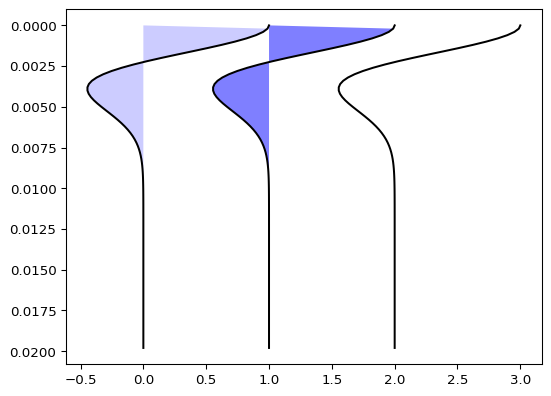pygimli.physics.seismics#
Full wave form seismics utilities and simulations
Overview#
Functions
|
Extract and show time series from wave field |
|
Draw signal in wiggle style into a given ax. |
|
Create Ricker wavelet. |
|
Solve pressure wave equation. |
Functions#
- pygimli.physics.seismics.drawSeismogram(ax, mesh, u, dt, ids=None, pos=None, i=None)[source]#
Extract and show time series from wave field
- pygimli.physics.seismics.drawWiggle(ax, x, t, xoffset=0.0, posColor='red', negColor='blue', alpha=0.5, **kwargs)[source]#
Draw signal in wiggle style into a given ax.
- Parameters:
ax (matplotlib ax) – To plot into
x (array [float]) – Signal.
t (array) – Time base for x
xoffset (float) – Move wiggle plot along x axis
posColor (str) – Need to be convertible to matplotlib color. Fill positive areas with.
negColor (str) – Need to be convertible to matplotlib color. Fill negative areas with.
alpha (float) – Opacity for fill area.
**kwargs (dict()) – Will be forwarded to matplotlib.axes.fill
Examples
>>> from pygimli.physics.seismics import ricker, drawWiggle >>> import matplotlib.pyplot as plt >>> import numpy as np >>> t = np.arange(0, 0.02, 1./5000) >>> r = ricker(t, 100., 1./100) >>> fig = plt.figure() >>> ax = fig.add_subplot(1,1,1) >>> drawWiggle(ax, r, t, xoffset=0, posColor='red', negColor='blue', ... alpha=0.2) >>> drawWiggle(ax, r, t, xoffset=1) >>> drawWiggle(ax, r, t, xoffset=2, posColor='black', negColor='white', ... alpha=1.0) >>> ax.invert_yaxis() >>> plt.show()

- pygimli.physics.seismics.ricker(f, t, t0=0.0)[source]#
Create Ricker wavelet.
Create a Ricker wavelet with a desired frequency and signal length.
- Parameters:
- Returns:
y – Signal
- Return type:
array_like
Examples
Create a 100 Hz Wavelet inside 1000 Hz sampled signal of length 0.1s.
>>> import matplotlib.pyplot as plt >>> import numpy as np >>> from pygimli.physics.seismics import ricker >>> sampleFrequenz = 1000 #Hz >>> t = np.arange(0, 0.1, 1./sampleFrequenz) >>> r = ricker(100., t, 1./100) >>> lines = plt.plot(t,r,'-x') >>> plt.show()

- pygimli.physics.seismics.solvePressureWave(mesh, velocities, times, sourcePos, uSource, verbose=False)[source]#
Solve pressure wave equation.
Solve pressure wave for a given source function
\[\begin{split}\frac{\partial^2 u}{\partial t^2} & = \diverg(a\grad u) + f\\ finalize equation\end{split}\]- Parameters:
mesh (GIMLI::Mesh) – Mesh to solve on
velocities (array) – velocities for each cell of the mesh
time (array) – Time base definition
sourcePos (RVector3) – Source position
uSource (array) – u(t, sourcePos) source movement of length(times) Usually a Ricker wavelet of the desired seismic signal frequency.
- Returns:
u – Return
- Return type:
RMatrix
Examples
See TODO write example